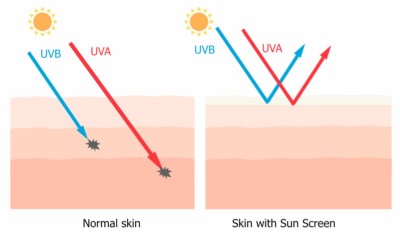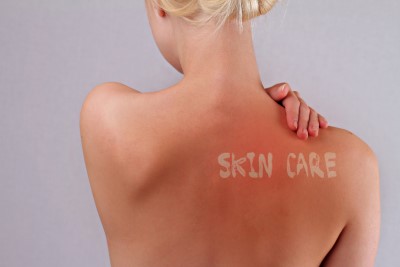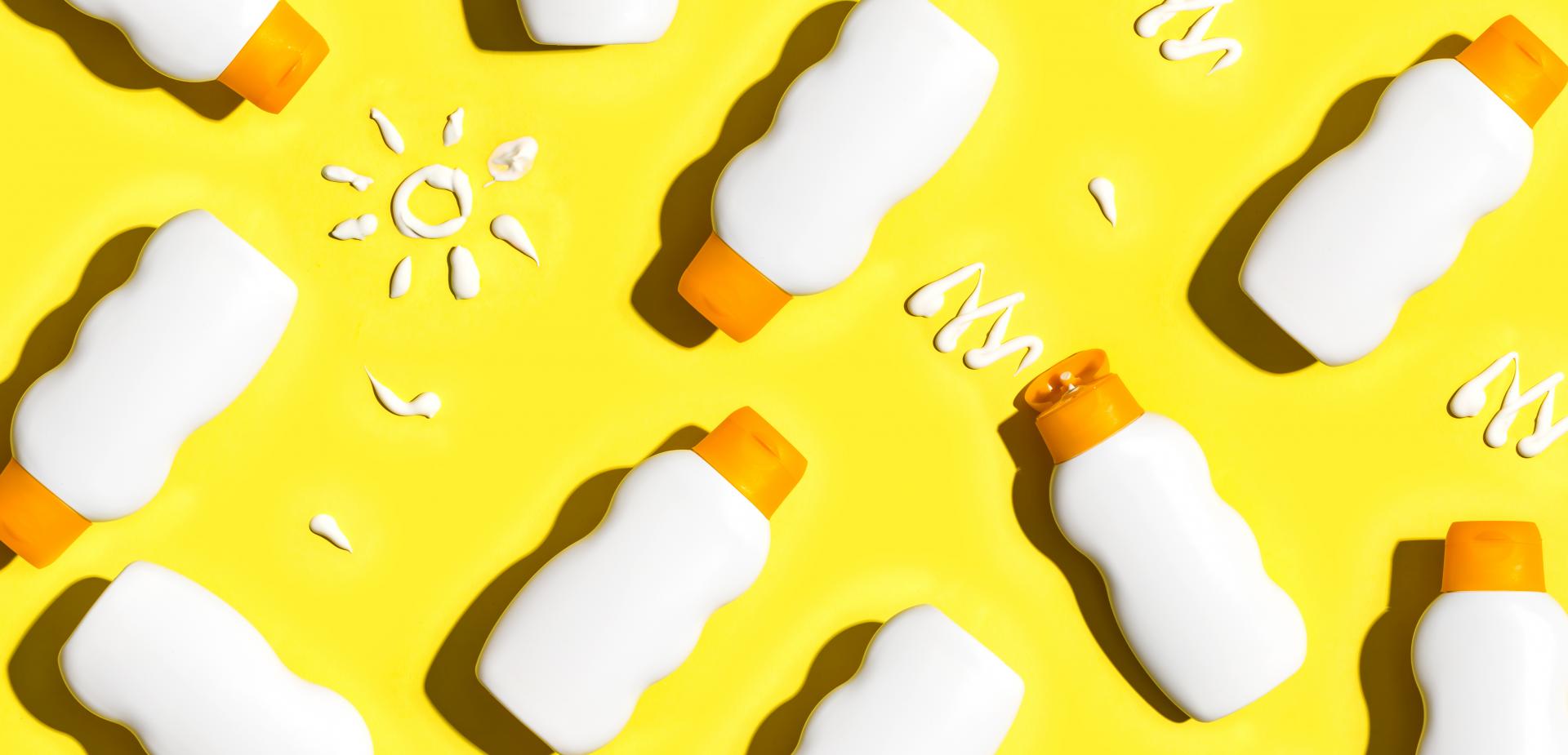The First Step to Improving Your Skin Health
Sunscreen Protects Your Skin from the Ravages of Free Radicals
The American Academy of Dermatology advises everyone to use sunscreen as protection against the sun’s ultraviolet rays, which are associated with the development of free radicals that cause extensive damage to the skin. In fact, the majority of non-melanoma and melanoma skin cancers, as well as signs of premature aging, are linked to UV rays.
Let’s take a look at how exposure to the sun stimulates the runaway chain of free radicals and why sunscreen is your first line of defense. We’ll also look at some popular sunscreen ingredients that have ironically been linked to the development of free radicals.
 The Sun’s Risky Business
The Sun’s Risky Business
According to the Skin Cancer Foundation, more Americans are diagnosed with skin cancer each year than all other forms of cancers combined.1 By age 70, one in five Americans will face a skin cancer diagnosis2 and actinic keratosis, the most common precancerous condition, affects over 58 million each year.3
Exposure to ultraviolet rays greatly increases your risk of developing both nonmelanoma and melanoma skin cancers, as well as actinic keratosis. In fact, 90 percent of nonmelanoma skin cancers and an estimated 86% of melanomas are linked to UV radiation from the sun.4,5
In addition, UV radiation is behind a more significant percentage of environmentally-related skin changes, including premature aging, than any other factor. UVA radiation also causes direct and indirect DNA damage.6
UV radiation from sunlight is classified as 3 different types. UVA rays, which have the longest wavelength, can penetrate into the middle layer of your skin (the dermis), causing long-term cellular damage, premature aging, and wrinkles. UVB rays, which have the shortest wavelength, reach the surface layer (epidermis), causing sunburn. UVC rays have more energy than either UVA or UVB rays but do not reach the atmosphere.
 UV Rays: Jump Starting Free Radicals
UV Rays: Jump Starting Free Radicals
Your skin cells have a remarkable ability to replace themselves. Cell turnover in your epidermis or top layer of the skin occurs about every 10 to 30 days. However, by the time we turn 30, the skin’s ability to regenerate is reduced and the rate of new cells being produced begins to slow down.
When we add in the factor of UV rays and free radicals, changes to the skin cells are accelerated and the skin’s ability to repair itself is even more limited. UV radiation is the primary cause of free radicals, the unstable oxygen molecules that lack paired electrons.
If you remember from science class, electrons need to be paired so these free radicals move through the body to steal electrons from other molecules. This sets off a chain reaction that causes damage at the molecular level, boosting the enzymes that break down collagen and altering the stem cell’s DNA, causing the depletion of stem cells. This leads to photo-aging or sun-related damage to the skin. Regular exposure to UV rays causes an estimated 90 percent of all skin aging.7
 Sunscreen: Your Line of Defense
Sunscreen: Your Line of Defense
What can you do to stop free radicals in their tracks? Your best defense against free radical damage is protecting your skin by applying sunscreen, which uses UV filters to limit the UV rays that reach through the skin’s surface. These filters work either by absorbing rays (chemical filters) or reflecting rays (physical blockers) before the rays are absorbed by DNA and other molecules in the skin’s inner layers.
The Skin Cancer Foundation recommends choosing a broad-spectrum sunscreen with an SPF of at least 15 for everyday activity and 30 or higher for extended outdoor exposure. Because most people don’t apply an adequate amount and because sunscreen easily rubs off, the organization advises reapplying every two hours.
Additional ways to protect your skin from free radical damage from UV rays include avoiding direct sun between 10 am and 4 pm, as well as wearing a hat, sunglasses, and clothing that covers arms and legs when spending time outdoors.
Can Sunscreen Cause Free Radical Damage?
While sunscreen is intended to block or reflect UV rays, could the sun’s radiation cause changes to the components in sunscreen? Researchers at two universities found a chemical reaction when commonly used sunscreens were exposed to sunlight that may cause sunscreen to lose its protective abilities and even increase free radicals.
Dr. Yinfa Ma, Curator’s Teaching Professor of chemistry at Missouri University of Science and Technology, and graduate student Quinbo Yang noticed a chemical reaction when zinc oxide nanoparticles are exposed to sunlight that releases electrons, generating unstable free radical molecules. Zinc oxide is a popular physical barrier sunscreen.8
In a study at the University of California at Riverside, chemist Kerry Hanson concluded that barrier sunscreens such as zinc oxide and titanium dioxide may break down in UV rays, not only losing their protective abilities but also generating more free radicals, which sunscreen is designed to eliminate. Hanson and team also discovered that octocrylene, another common sunscreen ingredient that penetrates the skin, acts as a photosensitizer, increasing free radicals.9
Does this mean you should avoid sunscreen? The researchers say the key is to reapply sunscreen every 2 hours to prevent the components from degrading in sunlight. In other words, your sunscreen needs sunscreen!
Although these ingredients, sensitive to the effects of sunlight, may react to create free radicals, taking steps to stabilize sunscreen ingredients, such as frequent application, can help.
 The Bottom Line
The Bottom Line
Exposure to the sun’s UV rays is responsible for the majority of skin cancers, as well as premature aging. UVA rays, which are absorbed by the skin’s surface, and UVB rays, which penetrate the skin’s inner layers, damage the skin by creating free radicals. Limit free radical damage by applying a broad-spectrum sunscreen every two hours. Additional strategies include avoiding direct sunlight during peak hours.
Sun damage is challenging to avoid completely. To help combat the effects of UV-related free radical damage, Simple Beauty developed Skin-Brightening Spot Corrector, formulated with the antioxidant vitamin E, as well as kojic dipalmitate and skin-conditioning emulsifiers to diminish the appearance of dark spots and leave you with a clear, hydrated, and healthy complexion.
1 Cancer Facts and Figures 2018. American Cancer Society. https://www.cancer.org/content/dam/cancer-org/research/cancer-facts-and-statistics/annual-cancer-facts-and-figures/2018/cancer-facts-and-figures-2018.pdf.
2 Stern, RS. Prevalence of a history of skin cancer in 2007: results of an incidence-based model. Arch Dermatol 2010; 146(3):279-282.
3 The Lewin Group, Inc. The Burden of Skin Diseases 2005. Prepared for the Society for Investigative Dermatology, Cleveland, OH, and the American Academy of Dermatology Assn., Washington, DC, 2005.
4 Koh HK, Geller AC, Miller DR, et al. Prevention and early detection strategies for melanoma and skin cancer: Current status. Arch Dermatol 1996; 132(4):436-442.
5 Parkin DM, Mesher D, Sasieni P. Cancers attributable to solar (ultraviolet) radiation exposure in the UK in 2010. Br J Cancer 2011; 105:S66-S69.
6 Amaro-Ortiz, A., Yan, B., & D’Orazio, J. A. (2014). Ultraviolet radiation, aging and the skin: prevention of damage by topical cAMP manipulation. Molecules (Basel, Switzerland), 19(5), 6202–6219. http://doi.org/10.3390/molecules19056202
7 Taylor CR, Stern RS, Leyden JJ, Gilchrest BA. Photoaging/photodamage and photoprotection. J Am Acad Dermatol 1990; 22:1-15.
8 W Lin, Y Huang, XD Zhou, Y Ma. In vitro toxicity of silica nanoparticles in human lung cancer cells, Toxicology and applied pharmacology, 2006
9 Hanson, KM, Gratton, E, Bardeen, CJ. Sunscreen enhancement of UV-induced reactive oxygen species in the skin. Free Radic Biol Med. 2006 Oct 15;41(8):1205-12. Epub 2006 Jul 6.
